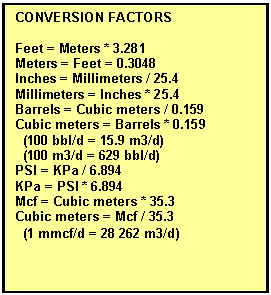|
 Productivity Index
Productivity Index
Estimating productivity is a useful way to
compare the quality of wells from similar reservoirs, even when
results are not calibrated. Calibration to core permeability is
practical in most sands and shaly sands. Carbonate
reservoirs are more heterogeneous and calibration of log
analysis productivity estimates is not usually possible.
Pressure transient analysis to estimate flow capacity, KH,
is useful for all reservoirs, and the equations below offer
a quick look method to solve for productivity from any
source. These are simplified versions of the equations, and
reservoir engineers may use more exact solutions.
STEP 1: Productivity index
1: Qo = KV1 *
Kh * (PF – PS) / VISO
2: Qg = KV2 *
Kh * ((PF – PS) ^ 2) / (FT + KT2)
Where: KV1 = 0.0001 for English units (bbl/day)
KV1 = 0.000 007
560 for Metric units (m3/d)
KV2 = 0.0001
for English units (mcf/day)
KV2 = 0.000 010
920 for Metric units (m3/d)
KT2 = 460 'F
for English units
KT2 = 273 'C
for Metric units
Results are in bbl/day or m3/day for oil and mcf/d
or e3m3/day for gas. The estimated flow rate (Qo or Qg) is
called the initial deliverability, Qd. Wells are often rate
limited by law or facilities to an initial rate, Qi, which is
less than deliverability, Qd.
Where:
BHT = bottom hole temperature (degrees F or degrees C)
BHTDEP = depth of bottom hole temperature (ft or m)
DEPTH = average formation depth (ft or m)
Kh = flow capacity or permeability-thickness product (md-ft or
md-m)
PFa = average formation pressure (psi or KPa)
 PSa = average surface or pipeline delivery pressure (psi or KPa) PSa = average surface or pipeline delivery pressure (psi or KPa)
SUFT = actual surface (degrees F or degrees C)
TFa = formation temperature, absolute (degrees F or degrees C)
Qg = productivity gas (mcf/day or m3/day)
Qo = productivity oil (bbl/day or m3/day)
VISO = oil viscosity (cp)
 COMMENTS:
COMMENTS:
These
formulae are "log analysis" versions of more complex
formulae should be used as guides to well quality only. Any resemblance
to absolute open flow data or real well tests is coincidental.
It is most useful for comparing the potential of two or more zones
to help decide which one to complete first. The highest Qo will
probably earn the most money or at least return it soonest.
 RECOMMENDED
PARAMETERS:
RECOMMENDED
PARAMETERS:
None
 NUMERICAL
EXAMPLE:
NUMERICAL
EXAMPLE:
1. Assume data for Sand B at 1000 meters (3000 feet):
P = 1800 psi
VISO = 1.0 cp
FT = 160 degrees Fahrenheit
THICK = 15 feet
Perm = 670 md
Kh = 15 * 679 = 10185 md-ft
If
oil well:
Qo = 0.1 * 10185 * 1800 / (1000 * 1.0) = 1833 bopd
If gas well:
Qg = 0.0001 * 10185 * (1800 ^ 2) / (160 + 460) =
5322 mcf/day
|

